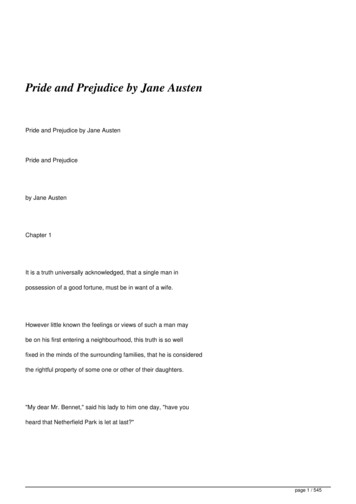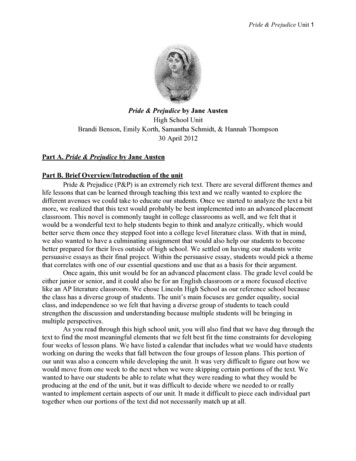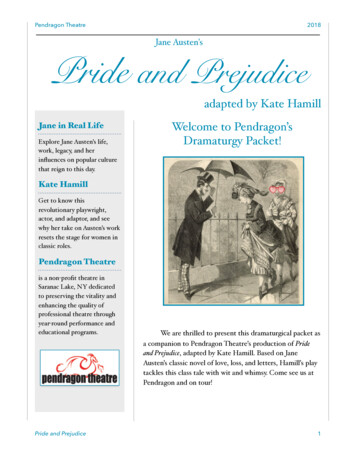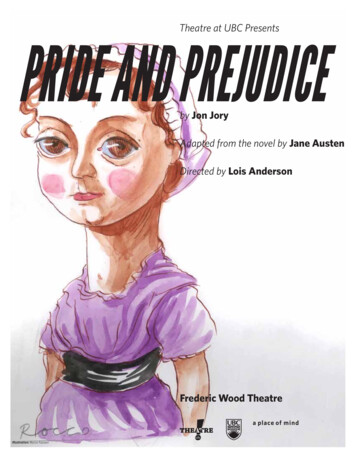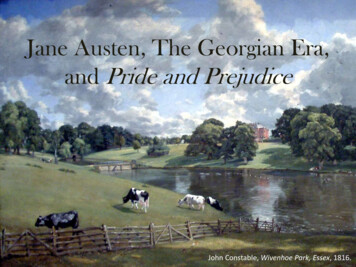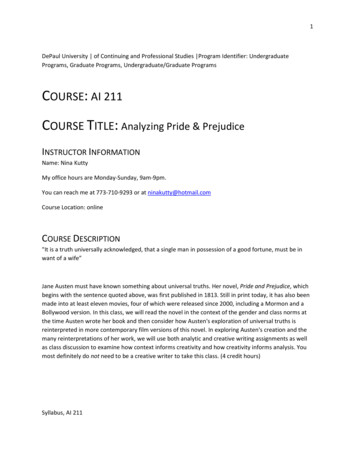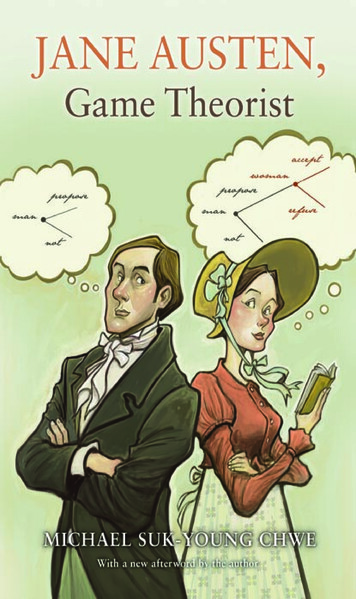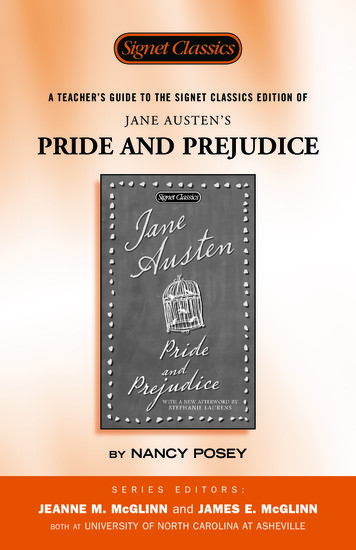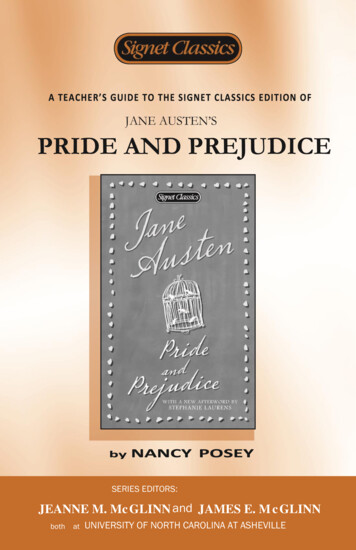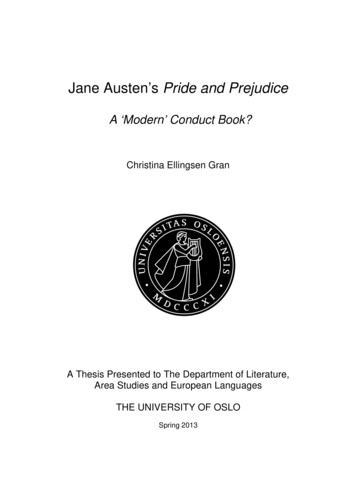
Transcription
Jane Austen’s Pride and PrejudiceA ‘Modern’ Conduct Book?Christina Ellingsen GranA Thesis Presented to The Department of Literature,Area Studies and European LanguagesTHE UNIVERSITY OF OSLOSpring 2013
Christina Ellingsen Gran2013Jane Austen’s Pride and Prejudice: A ‘Modern’ Conduct Book?Christina Ellingsen Granhttp://www.duo.uio.no/Print: Reprosentralen, Universitetet i OsloII
III
IV
AbstractThe overall purpose of this thesis is to compare and contrast Jane Austen’s intentions behindthe portrayal of two of her male characters, Mr. Darcy and Mr. Wickham, in Pride andPrejudice, with particular emphasis on the consequences of their behaviour for the femalecharacters in the novel.The conduct of both Mr. Darcy and Mr. Wickham has great influence on the women inthe novel. According to contemporary conduct rules they both behave improperly on severaloccasions. While Mr. Darcy goes through an internal change as the story develops andbecomes a proper gentleman, Mr. Wickham does not change and he is finally revealed to bean imposter.I will focus on how the male characters not only create an ordinary plot and ‘drive’ inthe novel, but how Austen’s portrayal is of greater symbolic importance. While Mr. Wickhamdisplays what is wrong in society, I believe Mr. Darcy’s development is symbolic of a greaterchange Austen wished for in society. She describes women’s unfair position in a patriarchalsociety and how the upper class manipulate social rules to ‘keep out’ people from the lowerclasses. She stresses the importance of good morals and conduct in order to restore fairnessand equality in society.In order to understand the moral standards and to perform a critical discussion ofmorals and conduct rules, I will draw on the literary theory of New Historicism and examineconduct rules from Austen’s contemporary society. The main sources for this thesis, besidesPride and Prejudice, are James Fordyce’s conduct book Addresses to Young Men, and LordChesterfield's Advice to His Son, on Men & Manners.V
VI
AcknowledgementsFirst, I would like to thank my supervisor Einar Bjorvand for all his constructive and positivefeedback. He was the first teacher to introduce me to Jane Austen and I would like to thankhim for the inspiration. Second, I would like to give a special thanks to the staff working atthe University of Oslo library who are always helpful and kind to a stressed out masterstudent. Third and finally, I would like to thank my friends, family and especially my momwho supported and helped me throughout my education and during my master’s degree.Thank you.VII
VIII
Table of ContentsChapter One: Introduction . 11.1Theory. 21.2Conduct books . 4Chapter Two: The Perfect Gentleman: Mr. Darcy . 92.1Pride . 102.2Prejudice . 162.3Class. 19Chapter Three: The Wicked: Mr. Wickham. 283.1Lying . 293.2Vanity . 333.3Moral Character . 38Chapter Four: Conclusion . 44Works Cited. 49IX
Chapter One: IntroductionThere are several reasons for choosing Jane Austen and her work Pride and Prejudice as atopic for my master’s thesis. Firstly, I find it impressive and interesting that the work hassurvived as a popular novel through centuries of social and political turbulence and is todaystill a part of the literary canon. Secondly, the themes in the novel speak to me and fascinateme. Every time I read Pride and Prejudice I ‘discover’ something new. I consider the work tobe one of the best examples of Austen’s brilliance as an author. The fact that I always findsomething ‘new’ in her novel motivated me to write a master’s thesis on it; although Austen isperhaps one of the most studied female authors, as a student I feel that I can still contributesomething to the literary criticism that already exists. Finally, this year, 2013, is the 200thanniversary of the first publication of Jane Austen’s Pride and Prejudice in 1813. I find itfitting to celebrate this anniversary by writing a master’s thesis on the novel; in addition, thefact that I wish to write a thesis on Austen’s work today is yet another proof of her brillianceand that Pride and Prejudice is still of current interest and an important literary work forreaders today.Pride and Prejudice is Austen’s best-known work. The protagonist in the novel isMiss Elizabeth Bennet, an intelligent and ‘headstrong girl’ (Austen 232). Naturally, since thenovel is written by a woman and the protagonist is female, the novel may be said to illustratewomen’s position in late 18th -century English society. The period was patriarchal and womenwere the weaker gender. The novel displays how women experienced the unfairness ofsociety and how men had power over women. Jane Austen herself belonged to the landedgentry or upper middle class and the setting of the novel is believed to be a good descriptionof late 18th and early 19th -century upper middle class society.Perhaps one of the most important aspects of 18th -century English society thatrestricted women’s freedom was the existence of conduct rules. Women were closely watchedand judged in social gatherings based on whether or not they behaved properly according tosocial norms. Bad conduct could mean the downfall of a young woman’s reputation andhence of her marriage possibilities. Rules of conduct also applied to men. However, men hada bigger advantage in being the privileged gender and the rules of conduct they followed bothdirectly and indirectly affected women. Some conduct rules were abused by the upper class torestrict the lower classes’ entry into the social elite. Marriage beneath one’s social rank was1
one of the challenges to their position that the upper class tried to prevent, which had anespecially large impact on women.In this master’s thesis I will discuss: firstly, the existence of conduct books/rules inAusten’s contemporary society and Austen’s incorporation of them into Pride and Prejudice.Secondly, how the two male characters Mr. Darcy and Mr. Wickham break conduct rules andhow their behaviour affects women. Thirdly, I will discuss what Austen’s intention behind theportrayal of the two male characters might be. In my discussion it is necessary to compare thetwo male characters with other characters in the novel, but the main focus is on the twogentlemen in question. The main sources will be (in addition to Pride and Prejudice) conductbooks from Austen’s contemporary society.1.1 TheoryThis master’s thesis will draw on the literary theory of ‘New Historicism’. This section willgive a short definition of what New Historicism is, and discuss how and why this theory is themost relevant for the analysis of the chosen topic.A simple definition of the new historicism is that it is a method based on the parallelreading of literary and non-literary texts, usually of the same historical period. That isto say, new historicism refuses (at least ostensibly) to ‘privilege’ the literary text:instead of a literary ‘foreground’ and a historical ‘background’ it envisages andpractises a mode of study in which literary and non-literary texts are given an equalweight and constantly inform or interrogate each other (Barry 172).New Historicism made its mark in the literary world during the 1970s, but it was not until the1980s that Stephen Greenblatt coined the term ‘new historicism’. Greenblatt usedcontemporary historical documents which overlapped in some way with the subject matter ofhis study. The historical documents he used were not subordinated as contexts, but wereanalyzed in their own right; a more fitting word instead of ‘contexts’ would perhaps be ‘cotexts’. The text and the co-text will be seen as expressions of the same historical ‘moment’(Barry 173).It is important to emphasize the fact that New Historicist essays always constituteanother remaking, another permutation of the past: as the text under discussion is juxtaposed2
with the chosen document, so a new entity is formed. In this sense the objection that thedocuments selected may not really be ‘relevant’ to the text is disarmed, for the main aim isnot to represent the past as it really was, but to present a new reality by re-situating it (Barry175). In other words, New Historicists claim that there is no ‘objectivity’, that we experiencethe ‘world’ in language, and that all our representations of the world, our readings of texts andof the past, are informed by our own historical position, by values and politics that are rootedin them (Newton 152).After New Historicism made its mark in the world of literary theories, Jane Austen’sworks experienced a revival. New Historicism, as defined above, looks at the historicalcontext of the work and analyzes the ways in which the work has been influenced bycirculating ideas typical of the era in question. One started to study ideas that might beapparent in Austen’s works that had not yet been ‘discovered’. Pride and Prejudice, as withJane Austen’s other novels, is layered with themes which unfold themselves in further study.The theory made it especially interesting to study the position of women as presented in thenovel and what Jane Austen’s intentions behind the different portrayals might have been.Feminist ideas became popular, and to some critics such ideas were evident in Austen’s work.The popularity of the novel made new study possible, and the number of studies of JaneAusten has increased rapidly during the last decades. Female portrayal is a popular theme ofmany modern studies. However, feminists have often criticized New Historicism for notdiscussing gender in their analysis of a text. Nonetheless, as Sara Lennox argues,New Historicism can and needs to talk about the historicity of every text’s reception,how every interpretation of a text is constructed through the interests and needs of thatreader, her- or himself produced by a multiplicity of social and historical forces. Inaddition, without concluding that the collapse of universal claims to truth makes itimpossible to make any verifiable statements at all about the texts we treat, newhistoricists, feminists, and I myself finally need a clearer way to indicate our ownpolitical standpoint, our partisanship while we are writing our essays, to build theacknowledgement of our ‘positionality’ into our scholarship, to display self-consciouslyin our own writing the historicity we also discover in the works we analyze (168).One can argue that the theory of New Historicism allows one to focus on and investigateexactly what one thinks is interesting. Today, we seem to see how gender issues were clearly3
evident in Austen’s work, while her contemporary criticism praises her works for theirrealistic portrayal of everyday life and characters. In other words, her works and especiallyPride and Prejudice are realistic and gender issues are apparent; however, that was howsociety functioned and not necessarily social criticism as some critics claim today. Feministversions of New Historicism allow recovery of women’s texts with the selective enhancementof only such historical evidence as may colour the reader’s response with presentist concerns.To learn political lessons from the past we need to have it in black and white (Marcus 133).By using conduct books from Austen’s contemporary period, this thesis takes a NewHistoricist approach to the subject matter of this study. The thesis will explore typical conductrules for men from Austen’s contemporary period, and discuss how the male characters inPride and Prejudice are affected by them, but more importantly how the rules both directlyand indirectly affect the female characters in the novel. To use conduct books as a mainsource in the argumentation to support ones’ idea or claim is a New Historicist technique.1.2 Conduct booksIn order to discuss conduct books, a definition is in order: what are conduct books? I willadapt the definition used for courtesy literature in Jane Austen and Eighteenth-CenturyCourtesy Books:( ) I should apply this term to any work, or significant part of work, which sets forthfor the gentleman (or gentlewoman) first, the qualities or criteria, inherent or acquired,which he must possess; second, his formation (including his various interests,exercises, recreations, and amusements) and his educations; and third, his conduct(Fritzer 3).Conduct books include a set of rules or guidelines on how to behave respectably in public.Everything from how one is supposed to eat at formal dinners to how to dance and how to talkis mentioned in conduct books. Good conduct displayed good manners and one was able tomeasure to what extent plausible marriage candidates acted properly and what class they mostlikely belonged to.Today, conduct books constitute a historical source from the period in which theliterary works were published and read. Penelope Joan Fritzer emphasizes that conduct bookswere topics of everyday discourse of eighteenth-century propriety, and are themselves4
expressions of the implicit values of their culture (2). They give us an insight into thatperiod’s ideas and values. However, conduct books are not necessarily representative for thegeneral values and ideas in Austen’s period. Courtesy books were certainly widespread intheir influence, and Jane Austen certainly knew of them (Fritzer 2). However, conduct booksexperienced a decline in popularity after the new literary genre ‘the novel’ made its way intothe literary world. The novel, with its immensely more complex registration of manners, wasable to present contemporary social norms in a more lifelike and engaging way than conductbooks could (Gilmour 9). Pride and Prejudice is a novel, and it is tempting to say that itrepresents a modern courtesy book, or at least a new version of the conduct book more fittingfor Austen’s audience/readers. With this in mind, the study of conduct rules in Pride andPrejudice is of current interest, in particular what Austen wanted to portray by incorporatingand shedding light on some of the rules. In Pride and Prejudice one of the conduct books isreferred to in a negative way and we have to remember that not everybody agreed with all ofthe rules.Conduct books were popular during the 18th and early 19th centuries, perhapsespecially for women, but for men as well. The social hierarchy in England was flexible as thebeginning of a growing economy led to a new type of work and new fortunes (Gilmour 5).‘New money’ became a phenomenon that included people not from the old aristocracy or thelanded gentry. The new social group was accepted into the social circle of society’s elite tovarying degrees. An old family name still weighed heavily and harvested respect, and nomoney could ever compensate for the lack of a good family name. The ‘nouveaux riches’were granted social access more or less unwillingly, as the upper class needed more moneyand the new people desperately wanted in.Marriage is of course another aspect that contributed to this flexibility between thesocial classes. People married below their social class, or conversely married into the classabove them. This flexibility within the upper social sphere resulted in a diversity of customsand conduct at social gatherings and it was easy for the elite to spot and avoid the new, lessrespectable families. The upper class had long traditions in social etiquette, while the newgroup lacked this education and did not always know how to act properly in certain socialsituations.The ‘nouveaux riches’ and the other social climbers wanted to blend in and to beaccepted by the elite, and strived to follow the strict social rules of conduct carefully watchedand maintained by the upper class. Conduct books became increasingly popular, as they5
offered guidelines for good behaviour and a way of blending in with the social elite. Conductbooks addressed not only expected good conduct, but also what were considered good morals.Conduct books and religion often went hand in hand, since they fulfilled one another; goodmorals were often equal to Christian morals. Most families consequently owned a Bible andone or several conduct books.Women were thought to be more easily tempted to break rules of moral or socialconduct. The conduct books were to a large extent published for women to give them adviceon how to behave, dress, and avoid tempting situations and so on. In Pride and Prejudice oneof the most well-known conduct books from Austen’s contemporary society is referred to onmore than one occasion. The most direct reference to the conduct book is when the Bennets’cousin, Mr. Collins, is visiting and reads aloud from James Fordyce’s Sermons to YoungWomen, published in 1766. Mr. Collins is one of the characters in the book who is mostpreoccupied with conduct rules. He is also the most ridiculous character in the novel. This isan example of Austen’s ironic style and how she criticizes and ‘warns’ society that when itcomes to conduct rules, not all of them should be strictly followed. Mr. Collins considersconduct books proper entertainment for the women in the Bennet family and Lydia interruptshim. It is ironic that it is Lydia who interrupts him, as she later in the story elopes with Mr.Wickham and is in general the ‘wildest’ of the Bennet sisters, representing the clearest breakwith the prevailing conduct code.Conduct books were not only meant for women, books were also published to givemen advice on how to behave properly. Compared to James Fordyce’s Sermons to YoungWomen, no conduct book for men stands out particularly or is mentioned in Jane Austen’sother works. However, most of the conduct books intended for men discuss similar aspects ofwhat was considered proper behaviour. This text will draw on two conduct books fromAusten’s contemporary society and focus on various conduct rules discussed in these books.James Fordyce’s Addresses to Young Men, was published in 1777. Unlike his conductbook for women, this was published in Austen’s lifetime. James Fordyce was a preacher whospecialized in giving sermons on morality and conduct to young gentlemen and women(Fordyce, ODNB). Later he collected some of his sermons and published them as conductbooks that gave advice to men and women on how to behave properly. Austen uses Fordyce’sbook as a reference in Pride and Prejudice, albeit with a negative connotation; one couldclaim that some of the rules discussed in the conduct books for men still had a stronghold inAusten’s contemporary society. Austen criticized Fordyce’s conduct book for girls as too old6
fashioned; although she does not explicitly refer to his conduct book for men, it is reasonableto suppose she thought that that was also too rigid.In Jane Austen’s period, religion and Christianity had a vast influence on society. JaneAusten’s own father was a rector and she was familiar with Christian values and morals.Religion is not openly discussed in her novels; they are however pervaded by Christian valuesand especially morals. It is therefore of interest to look at what James Fordyce believed wereimportant Christian values, since they must represent ideas that were current in Austen’ssociety. Austen’s use of Fordyce’s conduct book indicates that whether Austen approved of itor not, it captured something typical of 18th- and 19th-century society.Lord Chesterfield wrote several letters to his son with advice on conduct and properbehaviour. After his death, these letters were compiled and published. Lord Chesterfield'sAdvice to His Son, on Men & Manners was published in 1774, and several editions appearedduring the 18th century and onward (Stanhope, ODNB). What is interesting about LordChesterfield’s book is that it was not intended to be published as a book, but rather aspersonal advice given to his son in the form of letters; thus it might be said to give the readeran insight behind the scenes of the strict conduct rules in the Georgian age (Gilmour 18). Itcertainly draws a contrast between the strict rules of conduct discussed in the letters and theactual language of the letters. The language of the letters demonstrates ‘the low opinion ofhuman nature, the cynical attitude to women, the cold, calculating approach to humanrelations’ (Gilmour 17). Thus, it is tempting to say that this conduct book must contain someof the general ideas concerning proper behaviour for men during Jane Austen’s period.The two conduct books are different and contribute to diverse insights into ‘popular’conduct rules. Fordyce’s conduct book, like Chesterfield’s letters, discusses personalcharacteristics and qualities. However, Fordyce’s book is more general and resembles asermon. Like his conduct book for girls, Sermons to Young Women, Fordyce’s book for menis written in the style of a public sermon. Chesterfield’s letters are more personal and detailed.These two conduct books complement each other. Fordyce gives an insight into what wasthought of as fitting conduct for all men, evidence of what must have been more or lessaccepted by society; Chesterfield gives an insight into what one man thought was necessaryadvice for his son.In the discussion, the text will focus on how these two conduct books present the sixaspects of Pride, Prejudice, Class, Lying/Truthfulness, Vanity and Moral Character. JaneAusten’s novel is titled Pride and Prejudice, and we understand that these two aspects7
represent two major themes in the novel. Due to the setting of the novel, within the upper andthe upper middle class, it is safe to assume that one other major theme is class and classdifference. Truthfulness and vanity are typical qualities discussed in conduct books and moralcharacter represents the overarching goal. These features are present in most of Austen’sworks and may represent aspects of society that Austen considered in need of improvement.Her novel was intended to shed light on the unfair position of women in society andconsequently improve it.8
Chapter Two: The Perfect Gentleman:Mr. DarcyJane Austen’s male characters are diverse. Some are comical, mean, weak and even difficultto make out. Others are intelligent and strong-minded, like her female protagonists. In someof her novels, as in the case of Pride and Prejudice, the lead male character is rich andbelongs, financially and culturally, to a class above that of the female protagonist. Mr.Fitzwilliam Darcy has become a legend and the definition of a gentleman. Mr. Darcy wasraised in true aristocratic style. He is versed in the arts of culture, conversation, and goodconduct in general, a part of the upbringing of children from the upper class. He is describedas handsome, fine and tall, and he overall gives the air of being a noble gentleman (Austen 7).He is courageous, calm, intellectual and intelligent. In addition to these good traits, he is theowner of Pemberley and has an astonishing income of ten thousand a year.Despite his many good qualities, the readers’ first impression of Mr. Darcy is not at allpositive. The good people of Meryton first perceive him as proud and rude. Although he isconsidered proud, the reader is still captivated by his character. One may wonder whether ornot pride, prejudice and class make Mr. Darcy even more unreachable and attractive or ifreaders tend to forget or overlook these factors. The bad qualities are nevertheless vital to thestory’s development as Mr. Darcy is not humbled until Elizabeth rejects his marriageproposal. After the refusal, however, Mr. Darcy overcomes his pride and Elizabeth herprejudice and they can finally accept each other and fall in love. In line with the characters’inner struggle that results in the change in their personalities, the reader starts to like Mr.Darcy. He is flawed, which makes him human, as well as lovable and easy to relate to.This chapter will analyze examples from Pride and Prejudice where Mr. Darcy breakstraditional social conduct rules in order to be with Elizabeth Bennet. The analysis will focuson the conduct rules of pride, prejudice and class; it is the breaking of these rules that enableshim to follow his dream and marry for love. As well as examining his social liberation due tothe breaking of social rules, the text will take a closer look at how men and conduct rulesaffected not only Elizabeth, but also women in general. The text will argue that Jane Austen,through her portrayal of Mr. Darcy, is able to shed light on conduct rules she thought were toostrict and restrictive - to a certain extent for men, but more especially for women. The socialconduct rules for women were stricter; however, through male characters Jane Austen wasable to show how social rules for men also indirectly affected women. Through the portrayal9
of Mr. Darcy, Jane Austen is able to criticize the existing social rules and offer an alternativewith a happy outcome for both men and - perhaps especially - women. Jane Austen’scharacter Mr. Darcy doesn’t only serve as an example of how men should act from a femalepoint of view; through the novel’s great success, she was able to create the ideal man whommen have subsequently striven to imitate. At the same time, one may question whether or notshe made it more socially acceptable to break social rules which were too old-fashioned anddiscriminatory.2.1PrideJames Fordyce does not address pride in a separate paragraph or chapter. In the chapter ‘Onthe Beauty of Humility’, Fordyce stresses the importance of the quality of humility. Humilityis the opposite of pride, thus the chapter indirectly addresses pride.Sooner or later too they [young men] may be convinced by experience, that pride,whatever show she may make, or whatever deception she may practise, for a while, issecretly conscious of as much imbecility as insolence, and seldom fails at last to incura mixture of contempt, dislike and indignation (Fordyce 239).Lord Chesterfield addresses pride in the chapter called ‘Dignity of Manners’.Dignity of manners is not only as different from pride, as true courage is fromblustering, or true wit from joking, but it is absolutely inconsistent with it; for nothingvillifies and degrades more than pride. The pretensions of the proud man are oftenertreated with sneer and contempt, than with indignation; as we offer ridiculously to atradesman who asks ridiculously too much for his goods, but we do not haggle withone who only asks a just and reasonable price (Chesterfield 83).This section will analyse three occasions where Mr. Darcy clearly breaks the conduct rulesconcerning pride and discuss what effect this had on Elizabeth and on women in general. Thefirst example is from the ball at Netherfield, when Mr. Darcy and Elizabeth meet for the firsttime. The next examples are from Elizabeth’s visit to Netherfield after the ball. This is thesecond time Mr. Darcy and Elizabeth meet and from her very arrival there is a notion of Mr.10
Darcy’s interest in Elizabeth. The third and final example is during Elizabeth’s visit toPemberley. This is the first time Mr. Darcy and Elizabeth meet after her rejection of him.When Elizabeth and Mr. Darcy first meet, they are at the ball in Netherfield. Mr.Darcy is the biggest attraction at the ball. However, in accordance with Lord Chesterfield'swarning, people start to dislike Mr. Darcy:( ) he was looked at with great admiration for about half the evening, till hismanners gave a disgust which turned the tide of his popularity; for he was discoveredto be proud, to be above his company, and above being pleased; and not all his largeestate in Derbyshire could then save him from having a most forbidding, disagreeablecountenance, and being unworthy to be compared with his friend (Austen 8).Pride was a bad quality and Mr. Darcy breaks the conduct rule when he behaves with prideand offends the other guests at the ball. By some, he is excused because of his fortune: theyclaim he has the right to be proud and snobbish. Miss Lucas claims that Mr. Darcy’s pridedoes not offend her too much, because, as she asserts, there is an excuse for it. ‘One cannotwonder that so very fine a young man, with family, fortune, every thing in his favour, shouldthink highly of himself. If I may so express it, he has a right to be proud’ (Austen 14). If onetakes Charlotte Lucas’ opinion into consideration, one could argue that pride was more or lesssocially acceptable, if one could afford it. It may be safe to assume that it was probably anestablished way of thinking among the various classes and a tolerance reserved for the elite.Even though Miss Lucas can come to terms with and even accept Mr. Darcy’s pride,Elizabeth cannot. She says she would not have cared so much if her own pride h
Pride and Prejudice , are James Fordyce's conduct book Addresses to Young Men , and Lord Chesterfield's Advice to His Son, on Men & Manners . VI . VII Acknowledgements First, I would like to thank my supervisor Einar Bjorvand for all his constructive and positive feedback. He was the first teacher to introduce me to Jane Austen and I would .
